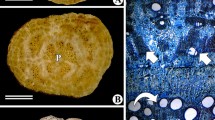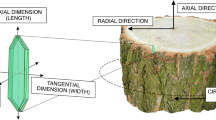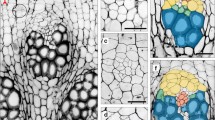Abstract
In a comparison of cambial cells and their derivatives between naturally occurring dwarf and normal trees, vessel elements and fibers in the annual rings of dwarf trees were found to be shorter, narrower and fewer than those of normal trees. The frequency of anticlinal divisions and loss of cambial initials were low during the differentiation of xylem cells from cambial initials in dwarf trees. The length and intrusive growth of fusiform initials were slightly less than those of normal trees. Thus, it was concluded that the shortening of vessel elements and fibers in dwarf trees was due to the fact that cambial initials were themselves shortened and underwent inactive intrusive growth during differentiation of the xylem mother cells.
Similar content being viewed by others
Literature cited
Baas, P., E. Werker and A. Fahn. 1983. Some ecological trends in vessel characters.IAWA Bull, n.s.,4: 141–159.
Baas, P., L. Chenglee, Z. Xinying, C. Keming and D. Yuefen. 1984. Some effects of dwarf growth on wood structure.IAWA Bull, n.s.,5: 45–63.
Bannan, M.W. 1957. The relative frequency of the different types of anticlinal divisions in conifer cambium.Canad. J. Bot.35: 875–884.
Bannan, M.W. and I.L. Bailey. 1956. Cell size and survival in conifer cambium.Canad. J. Bot.34: 769–776.
Bissing, D.R. 1982. Variation in qualitative anatomical features of the xylem of selected dicotyledonous woods in relation to water availability.Bull. Torrey Bot. Club109: 371–384.
Carlquist, S. 1975. Ecological strategies of xylem evolution. Univ. California Press, Berkeley, Los Angeles, London, pp. 174–222.
Chalk, L. 1951. Water and the growth of wood of Douglas fir. Quart.J. Forestry45: 237.
Dinwoodie, J.M. 1963. Variation in tracheid length inPicea sitchensis Carr.Forest products Research. Special Report No.16: 1–55.
Fahn, A. 1964. Some anatomical adaptations of desert plants.Phytomorphology.14: 93–102.
Ford, E.D., A.W. Robards and M.D. Piney. 1978. Influence of environmental factors on cell production and differentiation in the early wood ofPicea sitchensis.Ann. Bot.42: 683–692.
Forsaith, C.C. 1920. Anatomical reduction in some alpine plants.Ecology.1: 124–135.
Iqbal, M. and A.K.M. Ghouse. 1982. Environmental influence on growth activities ofProsopis spicigera. In: P.K. Khosla (ed.), Improvement of Forest Biomass: 387–393. ISTS, Sollan.
Iqbal, M. and A.K.M. Ghouse. 1983. An analytical study on cell size variation in some arid zone species of India:Acacia nilotica andProsopis spicigera.IAWA Bull. n.s.,4: 46–52.
Jensen, W.A. 1962. Botanical Histochemistry. W.H. Freeman and Company, pp. 55–99.
Kort, I. de. 1990. Tracheid length in vital and non vital Douglas fir (Pseudotsuga menziesii) in the Netherlands.IAWA Bull. n.s.,11: 203–209.
Kort, I.de. and P. Baas. 1986. Diktegroei en houtstructuur van vitale en niet-vitale Douglas in de Peel.Nederlands Bosbouwtijdschrift.58: 52–57
Larson, P.R. 1963. The indirect effect of drought on tracheid diameter in red pine.Forest. Sci.9: 52–62.
Lawton, R.O. 1984. Ecological constraints on wood density in a tropical montane rain forest.Am. J. Bot.71: 261–267.
Lim, D.O. and W.Y. Son. 1991. Comparative anatomy of secondary xylem in normal and dwarf individuals of some woody plants.Korean. J. Bot.34: 9–18.
Mahmooduzzafar and M. Iqbal. 1986. Variation in size and amount of wood elements across and within the growth rings inTerminalia tomentosa.Flora.178: 191–196.
Oever, L.van den, P. Baas and M. Zandee. 1981. Comparative wood anatomy ofSymplocos and latitude and altitude of provenance.IAWA Bull, n.s,2: 3–24.
Philipson, W.R., J.M. Ward and B.G. Butterfield. 1971. The vascular cambium -its development and activity-. Chapman and Hall Ltd. London, pp. 14–75.
Sass, J.E. 1971. Botanical Microtechnique. The Iowa State Univ. Press, Ames, Iowa. pp. 12–54.
Taylor, F.W. 1974. Differences in the wood ofEucalyptus grandis grown in different parts of South Africa.South African Forestry J.91: 14–18.
Zahner, R. 1968. Water deficits and growth of trees.In: T.T. Kozlowski (ed.), Water Deficits and Plant Growth: 191–254. Academic Press, New York.
Author information
Authors and Affiliations
Rights and permissions
About this article
Cite this article
Lim, D.O., Son, W.Y. Development of cambium and length of vessel elements and fibers in dwarfAlnus hirsuta (Spach) rupr. J. Plant Biol. 40, 245–248 (1997). https://doi.org/10.1007/BF03030455
Received:
Accepted:
Issue Date:
DOI: https://doi.org/10.1007/BF03030455




